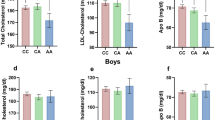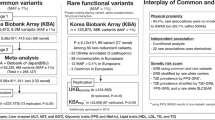Abstract
Objective:
Accumulating evidence raises the hypothesis that dysregulation of intrinsic clock mechanisms are involved in the development of the metabolic syndrome, type 2 diabetes mellitus and cardiovascular disease. The aim of the present study was to investigate the relationship between three known common polymorphisms in the Clock gene and features of the metabolic syndrome in man.
Methods:
Genotype and haplotype analysis was carried out in a cohort of 537 individuals from 89 families characterized for inflammatory, atherothrombotic and metabolic risk associated with insulin resistance.
Results:
Heritability of the metabolic syndrome, defined according to International Diabetes Federation criteria, was 0.40. Haplotype analysis indicated three common haplotypes: CAT, TGT and CGC (rs4864548-rs3736544-rs1801260) with frequencies of 31, 33 and 28%, respectively. The CGC haplotype was less prevalent in subjects with the metabolic syndrome (P=0.0015) and was associated with lower waist circumference (P=0.007), lower hip circumference (P=0.023), lower body mass index (P=0.043) and lower leptin levels (P=0.028). The CAT haplotype was significantly associated with the presence of the metabolic syndrome (P=0.020).
Conclusions:
These findings suggest that the Clock gene CGC haplotype may be protective for the development of obesity and support the hypothesis that genetic variation in the Clock gene may play a role in the development of the metabolic syndrome, type 2 diabetes and cardiovascular disease.
This is a preview of subscription content, access via your institution
Access options
Subscribe to this journal
Receive 12 print issues and online access
$259.00 per year
only $21.58 per issue
Buy this article
- Purchase on Springer Link
- Instant access to full article PDF
Prices may be subject to local taxes which are calculated during checkout
Similar content being viewed by others
References
Staels B . When the Clock stops ticking, metabolic syndrome explodes. Nat Med 2006; 12: 54–55.
Rajaratnam SM, Arendt J . Health in a 24-h society. Lancet 2001; 358: 999–1005.
Walters J, Skene D, Hampton SM, Ferns GA . Biological rhythms, endothelial health and cardiovascular disease. Med Sci Monit 2003; 9: RA1–RA8.
Liu C, Li S, Liu T, Borjigin J, Lin JD . Transcriptional coactivator PGC-1alpha integrates the mammalian clock and energy metabolism. Nature 2007; 447: 477–481.
Yang X, Downes M, Yu RT, Bookout AL, He W, Straume M et al. Nuclear receptor expression links the circadian clock to metabolism. Cell 2006; 126: 801–810.
Lund J, Arendt J, Hampton SM, English J, Morgan LM . Postprandial hormone and metabolic responses amongst shift workers in Antarctica. J Endocrinol 2001; 171: 557–564.
Nagaya T, Yoshida H, Takahashi H, Kawai M . Markers of insulin resistance in day and shift workers aged 30–59 years. Int Arch Occup Environ Health 2002; 75: 562–568.
Karlsson BH, Knutsson AK, Lindahl BO, Alfredsson LS . Metabolic disturbances in male workers with rotating three-shift work. Results of the WOLF study. Int Arch Occup Environ Health 2003; 76: 424–430.
Spiegel K, Knutson K, Leproult R, Tasali E, Van Cauter E . Sleep loss: a novel risk factor for insulin resistance and type 2 diabetes. J Appl Physiol 2005; 99: 2008–2019.
Reilly JJ, Armstrong J, Dorosty AR, Emmett PM, Ness A, Rogers I et al. Early life risk factors for obesity in childhood: cohort study. BMJ 2005; 330: 1357.
Knutsson A . Health disorders of shift workers. Occup Med (Lond) 2003; 53: 103–108.
Dunlap JC . Molecular bases for circadian clocks. Cell 1999; 96: 271–290.
Lincoln GA, Andersson H, Loudon A . Clock genes in calendar cells as the basis of annual timekeeping in mammals—a unifying hypothesis. J Endocrinol 2003; 179: 1–13.
Holzberg D, Albrecht U . The circadian clock: a manager of biochemical processes within the organism. J Neuroendocrinol 2003; 15: 339–343.
Fontaine C, Dubois G, Duguay Y, Helledie T, Vu-Dac N, Gervois P et al. The orphan nuclear receptor Rev-Erbalpha is a peroxisome proliferator-activated receptor (PPAR) gamma target gene and promotes PPARgamma-induced adipocyte differentiation. J Biol Chem 2003; 278: 37672–37680.
Ando H, Yanagihara H, Hayashi Y, Obi Y, Tsuruoka S, Takamura T et al. Rhythmic mRNA Expression of Clock Genes and Adipocytokines in Mouse Visceral Adipose Tissue. Endocrinology 2005; 146: 5631–5636.
Rudic RD, McNamara P, Curtis AM, Boston RC, Panda S, Hogenesch JB et al. BMAL1 and CLOCK, two essential components of the circadian clock, are involved in glucose homeostasis. PLoS Biol 2004; 2: e377.
Turek FW, Joshu C, Kohsaka A, Lin E, Ivanova G, McDearmon E et al. Obesity and metabolic syndrome in circadian Clock mutant mice. Science 2005; 308: 1043–1045.
Kennaway DJ, Owens JA, Voultsios A, Boden MJ, Varcoe TJ . Metabolic homeostasis in mice with disrupted Clock gene expression in peripheral tissues. Am J Physiol Regul Integr Comp Physiol 2007; 293: R1528–R1537.
Freeman MS, Mansfield MW, Barrett JH, Grant PJ . Insulin resistance: an atherothrombotic syndrome. The Leeds family study. Thromb Haemost 2003; 89: 161–168.
Freeman MS, Mansfield MW, Barrett JH, Grant PJ . Heritability of features of the insulin resistance syndrome in a community-based study of healthy families. Diabet Med 2002; 19: 994–999.
Alberti KG, Zimmet P, Shaw J . The metabolic syndrome—a new worldwide definition. Lancet 2005; 366: 1059–1062.
Freeman MS, Mansfield MW, Barrett JH, Grant PJ . Genetic contribution to circulating levels of hemostatic factors in healthy families with effects of known genetic polymorphisms on heritability. Arterioscler Thromb Vasc Biol 2002; 22: 506–510.
Barrett JC, Fry B, Maller J, Daly MJ . Haploview: analysis and visualization of LD and haplotype maps 1. Bioinformatics 2005; 21: 263–265.
Lange C, DeMeo D, Silverman EK, Weiss ST, Laird NM . PBAT: tools for family-based association studies. Am J Hum Genet 2004; 74: 367–369.
Bayoumi RA, Al Yahyaee SA, Albarwani SA, Rizvi SG, Al Hadabi S, Al Ubaidi FF et al. Heritability of determinants of the metabolic syndrome among healthy Arabs of the Oman family study. Obesity (Silver Spring) 2007; 15: 551–556.
Lin HF, Boden-Albala B, Juo SH, Park N, Rundek T, Sacco RL . Heritabilities of the metabolic syndrome and its components in the Northern Manhattan Family Study. Diabetologia 2005; 48: 2006–2012.
Tortorella A, Monteleone P, Martiadis V, Perris F, Maj M . The 3111T/C polymorphism of the CLOCK gene confers a predisposition to a lifetime lower body weight in patients with anorexia nervosa and bulimia nervosa: a preliminary study. Am J Med Genet B Neuropsychiatr Genet 2007; 144: 992–995.
Bray MS, Young ME . Circadian rhythms in the development of obesity: potential role for the circadian clock within the adipocyte. Obes Rev 2007; 8: 169–181.
Scott EM, Grant PJ . Neel revisited: the adipocyte, seasonality and type 2 diabetes. Diabetologia 2006; 49: 1462–1466.
Benedetti F, Dallaspezia S, Fulgosi MC, Lorenzi C, Serretti A, Barbini B et al. Actimetric evidence that CLOCK 3111 T/C SNP influences sleep and activity patterns in patients affected by bipolar depression. Am J Med Genet B Neuropsychiatr Genet 2007; 144: 631–635.
Mishima K, Tozawa T, Satoh K, Saitoh H, Mishima Y . The 3111T/C polymorphism of hClock is associated with evening preference and delayed sleep timing in a Japanese population sample. Am J Med Genet B Neuropsychiatr Genet 2005; 133: 101–104.
Katzenberg D, Young T, Finn L, Lin L, King DP, Takahashi JS et al. A CLOCK polymorphism associated with human diurnal preference. Sleep 1998; 21: 569–576.
Iwase T, Kajimura N, Uchiyama M, Ebisawa T, Yoshimura K, Kamei Y et al. Mutation screening of the human Clock gene in circadian rhythm sleep disorders. Psychiatry Res 2002; 109: 121–128.
Benedetti F, Serretti A, Colombo C, Barbini B, Lorenzi C, Campori E et al. Influence of CLOCK gene polymorphism on circadian mood fluctuation and illness recurrence in bipolar depression. Am J Med Genet B Neuropsychiatr Genet 2003; 123: 23–26.
Pirovano A, Lorenzi C, Serretti A, Ploia C, Landoni S, Catalano M et al. Two new rare variants in the circadian ‘clock’ gene may influence sleep pattern. Genet Med 2005; 7: 455–457.
Serretti A, Cusin C, Benedetti F, Mandelli L, Pirovano A, Zanardi R et al. Insomnia improvement during antidepressant treatment and CLOCK gene polymorphism. Am J Med Genet B Neuropsychiatr Genet 2005; 137: 36–39.
Serretti A, Benedetti F, Mandelli L, Lorenzi C, Pirovano A, Colombo C et al. Genetic dissection of psychopathological symptoms: insomnia in mood disorders and CLOCK gene polymorphism. Am J Med Genet B Neuropsychiatr Genet 2003; 121: 35–38.
Pedrazzoli M, Louzada FM, Pereira DS, Benedito-Silva AA, Lopez AR, Martynhak BJ et al. Clock polymorphisms and circadian rhythms phenotypes in a sample of the Brazilian population. Chronobiol Int 2007; 24: 1–8.
Gorlova OY, Amos CI, Wang NW, Shete S, Turner ST, Boerwinkle E . Genetic linkage and imprinting effects on body mass index in children and young adults. Eur J Hum Genet 2003; 11: 425–432.
Almasy L, Goring HH, Diego V, Cole S, Laston S, Dyke B et al. A novel obesity locus on chromosome 4q: the Strong Heart Family Study. Obesity (Silver Spring) 2007; 15: 1741–1748.
King DP, Zhao Y, Sangoram AM, Wilsbacher LD, Tanaka M, Antoch MP et al. Positional cloning of the mouse circadian clock gene. Cell 1997; 89: 641–653.
Humphreys P, McCarthy M, Tuomilehto J, Tuomilehto-Wolf E, Stratton I, Morgan R et al. Chromosome 4q locus associated with insulin resistance in Pima Indians. Studies in three European NIDDM populations. Diabetes 1994; 43: 800–804.
Permutt MA, Wasson JC, Suarez BK, Lin J, Thomas J, Meyer J et al. A genome scan for type 2 diabetes susceptibility loci in a genetically isolated population. Diabetes 2001; 50: 681–685.
Prochazka M, Lillioja S, Tait JF, Knowler WC, Mott DM, Spraul M et al. Linkage of chromosomal markers on 4q with a putative gene determining maximal insulin action in Pima Indians. Diabetes 1993; 42: 514–519.
Gomez-Abellan P, Hernandez-Morante JJ, Lujan JA, Madrid JA, Garaulet M . Clock genes are implicated in the human metabolic syndrome. Int J Obes (Lond) 2007 [e-pub ahead of print].
Author information
Authors and Affiliations
Corresponding author
Rights and permissions
About this article
Cite this article
Scott, E., Carter, A. & Grant, P. Association between polymorphisms in the Clock gene, obesity and the metabolic syndrome in man. Int J Obes 32, 658–662 (2008). https://doi.org/10.1038/sj.ijo.0803778
Received:
Revised:
Accepted:
Published:
Issue Date:
DOI: https://doi.org/10.1038/sj.ijo.0803778
Keywords
This article is cited by
-
Sex-dependent relationship of polymorphisms in CLOCK and REV-ERBα genes with body mass index and lipid levels in children
Scientific Reports (2023)
-
Circadian regulation of liver function: from molecular mechanisms to disease pathophysiology
Nature Reviews Gastroenterology & Hepatology (2023)
-
Identification of the Relationship Between DNA Methylation of Circadian Rhythm Genes and Obesity
Biochemical Genetics (2023)
-
Circadian mechanism disruption is associated with dysregulation of inflammatory and immune responses: a systematic review
Beni-Suef University Journal of Basic and Applied Sciences (2022)
-
Stabilization of heterochromatin by CLOCK promotes stem cell rejuvenation and cartilage regeneration
Cell Research (2021)



